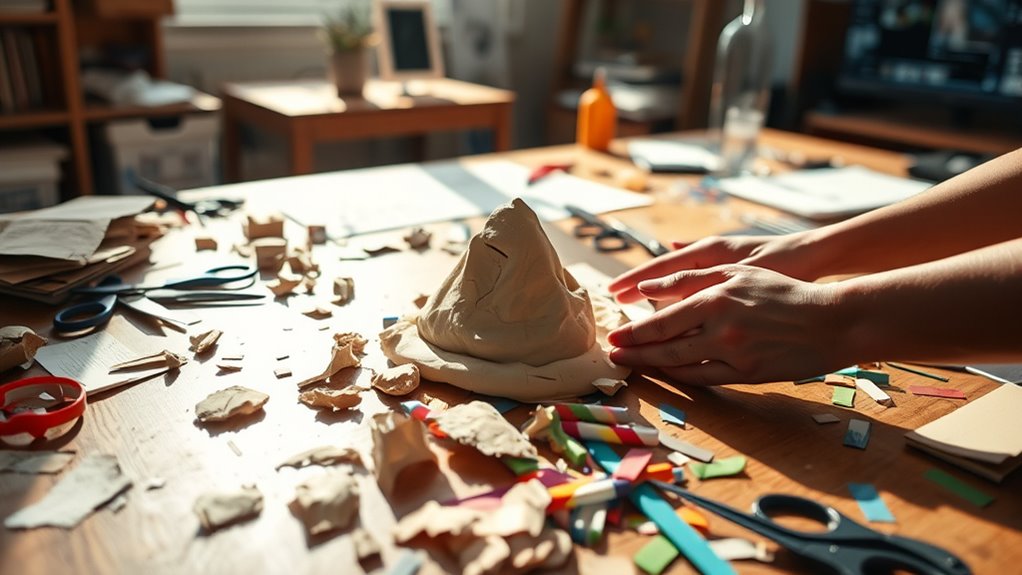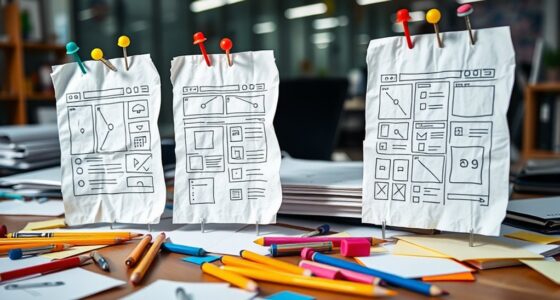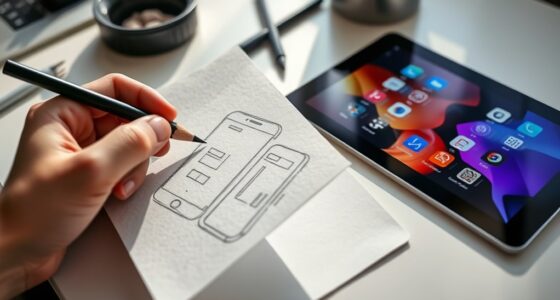Prototyping in a day using cardboard, clay, and other low-fidelity hacks is all about quick, simple, and effective testing. Focus on basic materials that match your project goals and prioritize safety. Use fast techniques like folding, cutting, and assembling to build models swiftly. Test your prototype regularly, gather honest feedback, and refine based on what you learn. Keep it simple, functional, and flexible—if you want to find out how to master this process, more tips await you.
Key Takeaways
- Use simple, readily available materials like cardboard and clay for quick, cost-effective prototyping.
- Focus on basic assembly techniques such as cutting, folding, and gluing to accelerate model creation.
- Prioritize functional features over aesthetics to test core ideas rapidly.
- Keep prototypes minimal and clear to facilitate easy modifications and user testing.
- Incorporate practical elements or features to demonstrate key concepts within limited time.
Getting Started With Simple Materials
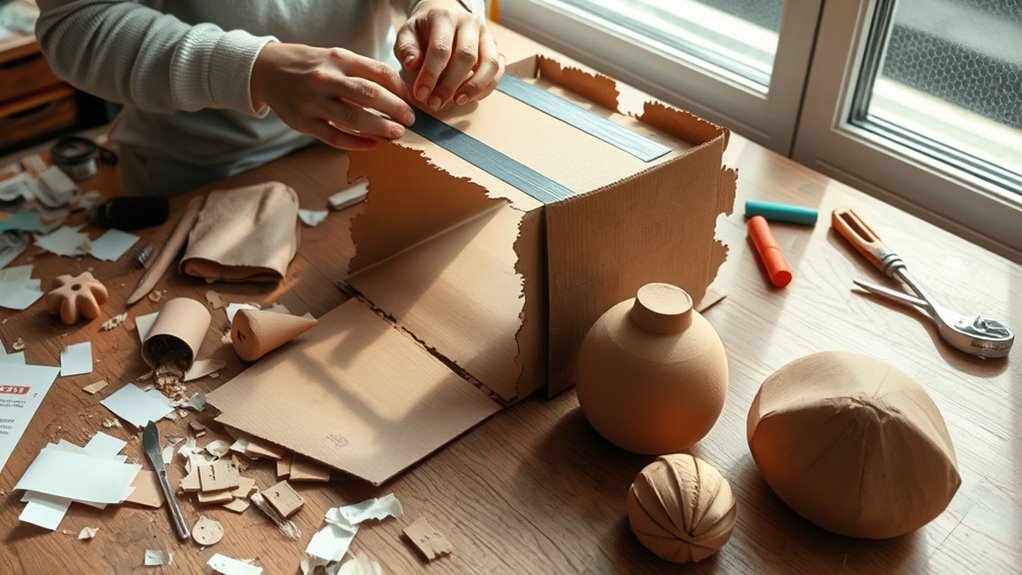
When you’re ready to begin prototyping, using simple materials can make the process both accessible and efficient. Start with basic options like cardboard, clay, or foam, which are easy to manipulate and readily available. Your material selection should align with your project’s goals, ensuring the prototype accurately reflects your design ideas without unnecessary complexity. Always keep safety considerations in mind—choose non-toxic, safe materials, and work in a well-ventilated area. Avoid sharp tools or hazardous substances, especially if others will handle the prototype. Using simple materials not only speeds up the initial development but also encourages experimentation. Focus on functionality first, then refine your design as needed, knowing that these low-fidelity tools are perfect for quick, safe, and cost-effective prototyping. Monitoring the costs of materials can help keep your project within budget while allowing for creative flexibility.
Techniques for Rapid Model Building
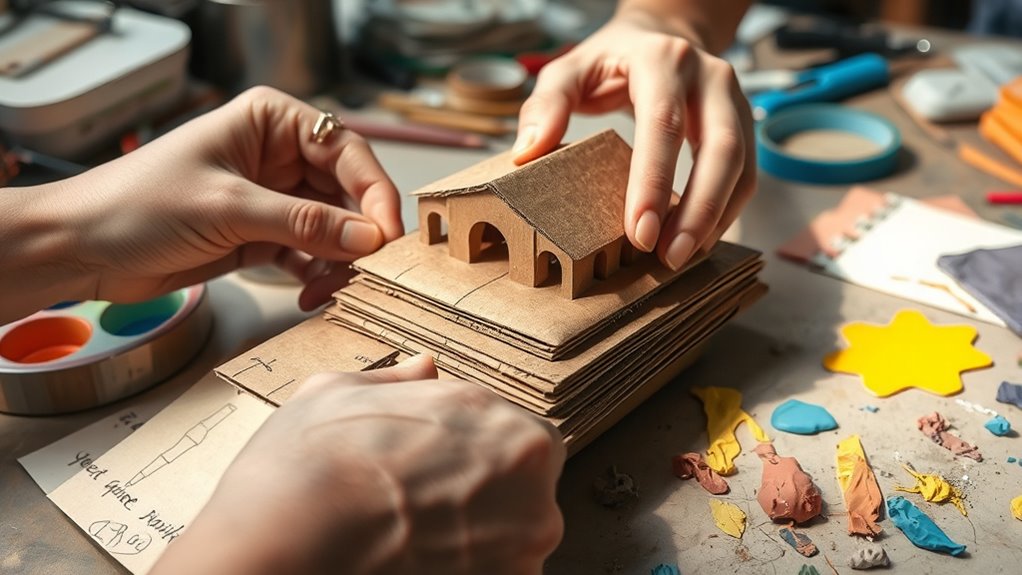
Building on your use of simple materials, adopting effective techniques for rapid model building allows you to create functional prototypes quickly. Focus on methods like folding, cutting, and assembling materials such as cardboard, clay, or foam to save time. Use lightweight, flexible options to make adjustments easily, enhancing the user experience by quickly testing different ideas. Pay attention to aesthetic considerations, keeping the prototype visually clear without overcomplicating details. Rely on quick fixes like tape or glue for fast assembly, and use markers or paint to highlight key areas. Incorporating self watering plant pots into your prototypes can demonstrate practical features effectively, saving time on complex systems. These techniques help you iterate swiftly, ensuring your prototype serves its purpose—gathering feedback and refining your design efficiently.
Tips for Effective Testing and Iteration
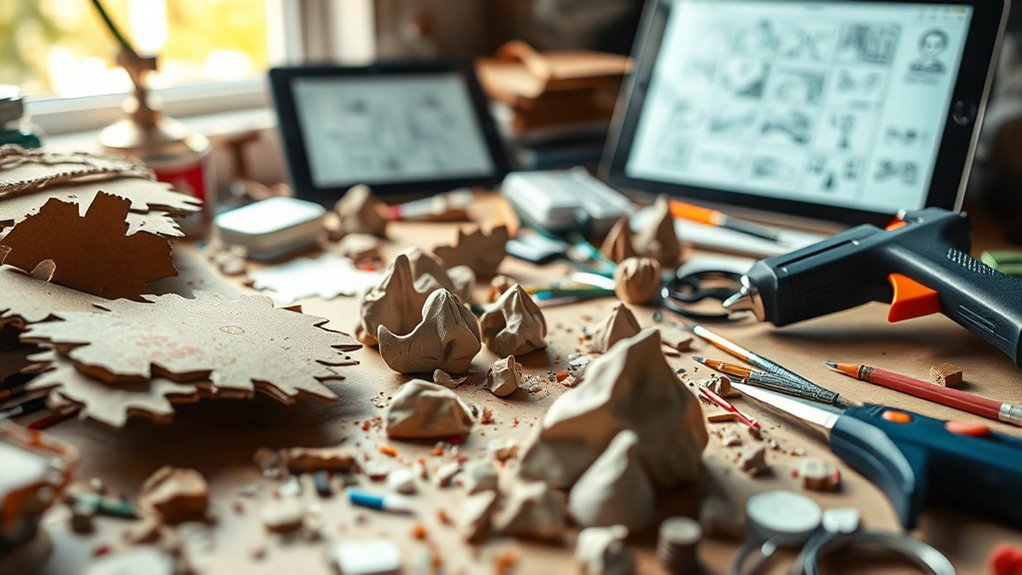
To maximize the value of your prototype, you need to approach testing and iteration with a clear plan and open mindset. Focus on observing how users interact with your low-fidelity model to gather meaningful feedback. Encourage honest feedback loops by asking specific questions about user experience, such as what worked well and what caused confusion. Keep testing sessions short, targeted, and frequent to identify issues early. Prioritize changes based on real user input rather than assumptions. Be prepared to adapt quickly—sometimes the smallest tweak can considerably improve usability. Remember, the goal is to learn, not to perfect your prototype. Continuous iteration based on genuine user feedback helps refine your concept efficiently, ensuring your final product better meets user needs. Additionally, understanding emotional support can help you better interpret user reactions and improve the empathetic design of your prototypes.
Frequently Asked Questions
How Do I Choose the Best Materials for My Prototype?
When choosing materials for your prototype, focus on material selection that matches your project’s goals and budget. Consider how long you need the prototype to last; for short-term testing, lightweight and inexpensive options like cardboard or clay work well. If you want durability, opt for sturdier materials. Always test your materials beforehand to make certain they meet your needs, balancing ease of use with prototype longevity.
What Tools Are Essential for Quick Model Assembly?
When assembling a quick model, you’ll need basic tools like scissors, craft knives, glue, and tape. Always follow safety precautions, especially when using sharp tools. To save costs, look for inexpensive or reusable options, like scrap cardboard or recycled materials. These tools help you build fast, cost-effective prototypes, letting you test ideas quickly without investing heavily. Just guarantee safety is your priority during the process.
How Can I Make Prototypes More Durable With Low-Fidelity Materials?
To make your prototypes more durable with low-fidelity materials, focus on material reinforcement. You can reinforce cardboard with tape or glue to prevent tearing, and add a thin layer of clay or plaster for stability. Conduct durability testing by applying gentle pressure or stress to identify weak spots. This way, you improve your prototype’s resilience, ensuring it withstands handling and testing without breaking easily.
What Common Mistakes Should I Avoid During Rapid Prototyping?
Did you know that 70% of prototypes fail to meet user needs due to common pitfalls? When rapid prototyping, avoid rushing through validation strategies—skipping this step leads to costly mistakes. Don’t neglect iteration or assume your first idea is perfect. Instead, test early, gather feedback, and refine. This approach helps you identify flaws quickly and guarantees your prototype effectively addresses user requirements without wasting time or resources.
How Do I Effectively Gather Feedback From Users on Simple Models?
To effectively gather feedback from users on simple models, you should conduct user testing early and often. Observe how they interact with your prototype and ask open-ended questions to understand their needs. Use feedback loops to refine your design iteratively, ensuring you address pain points. Keep the models straightforward so users can focus on the core functionality, making their feedback more valuable for your development process.
Conclusion
Now that you’ve explored simple materials and quick techniques, you’re ready to bring ideas to life in a flash. Think of low-fidelity prototyping as your creative launchpad—where rough sketches turn into tangible concepts in no time. Embrace the imperfections, learn from each iteration, and let your curiosity be the compass. With these hacks, you’ll turn brainstorming sessions into fast, fun experiments—like turning a spark into a blazing trail of innovation.
